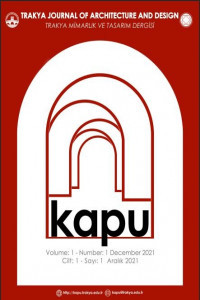SPATIAL ANALYSIS OF 2000-2018 RESIDENTIAL PRICES IN ISTANBUL
SPATIAL ANALYSIS OF 2000-2018 RESIDENTIAL PRICES IN ISTANBUL
House Price, Growth Suburbanization, Reconstructing,
___
- Alkay, E. (2008). Housing submarkets in Istanbul. Int. Real Estate Rev., 11(1), 113-127.
- Alkay, E., Watkins, C. & Keskin, B. (2018). Explaining spatial variation in housing .Int. J. Strateg. Prop. M., 22 (2), https://doi.org/10.3846/ijspm/.2018.443.
- Anderson, S.T. & West, S.E. (2006). Open space, residential property values, and spatial context Reg. Sci. Urban Econ., 36(6), https://doi.org/10.1016/j.regsciurbeco.2006.03.007.
- Ayatac, H. & Dokmeci, V. (2017). Location patterns of restaurants in Istanbul. Current Urban Stud., 5(2), DOI: 10.4236/cus.2017.52012.
- Bardo, J. W. & Dökmeci, V. (1992). Modernization, traditionalism, and the changing structure of community satisfaction in two sub-communities in Istanbul, Turkey: A Procrustean analysis. Genet., sol., gen. psych., 118(3). http://pascalfrancis. inist.fr/vibad/index.php?action:getRecordDetail&idt=4317033.
- Baycan-Levent, T. & Gülümser, A. A. (2007, September). Gated communities in Istanbul: The new walls of the city. In Third Conference Diversity in Cities: Visible and Invisible Walls, UCL, London, UK.
- Beyazit, E. (2015). Are wider economic impacts of transport infrastructures always beneficial? Impacts of the Istanbul Metro on the generation of spatial-economic inequalities. J. Trans. Georg., 45, https://doi.org/10.1016/j.jtrangeo.2015.0 3.009.
- Bourassa, S.C., Hoesli, M. & Sun, J. (2005). The price of aesthetic externalities. J. Real Estate Lit., 13 (2), https://www.jstor.org/staple/44103517.
- Clark, D. (2020). Gini Index Score of Turkey 2004-2018. www.statista.com.
- Dai, X., Bai, X. & Xu, M. (2016). The influence of Beijing rail transfer stations on surrounding housing prices. Habitat Int., 55, 79-88. https://doi.org/10.1016/j.habitatint.2016.02.008.
- Dincer, İ. (2011). The impact of neoliberal policies on historic urban space: Areas of urban renewal in Istanbul. Int. Plann. Stud., 16(1), https://doi.org//10.1080/13563475.2011.552474.
- Ding, C. & Knaap, G. J. (2002). Property values in inner‐city neighborhoods: The effects of homeownership, housing investment, and economic development. House. Policy Debate, 13(4), https://doi.org/10.1080/10511482.2002.9521462.
- Dokmeci, V., Altunbas, U. & Yazgi, B. (2007). Revitalization of the main street of a distinguished old neighborhood in Istanbul. Eur.Plan.Stud.,15(1), https://doi.org/10.1080/09654310601016788.
- Dokmeci, V. & Berkoz, L.(1994).Transformation of Istanbul from a monocentric to a polycentric city. Eur.
- Plan. Stud., 2(2), https://doi.org/10.1080/09654319408720259.
- Dokmeci, V. & Berkoz, L. (2000). Residential-location preferences according to demographic characteristics in Istanbul. Landscape and Urban Plan., 48(1-2), https://doi.org/10.1016/S0169-2046(99)00080-8.
- Dokmeci, V. & Ciraci, H. (1999). From westernization to globalization: an old district of Istanbul. Plann. Hist., 21(3), 13-23.
- Dokmeci, V., Onder, Z. & Yavas, A. (2003). External factors, housing values, and rents: evidence from survey data. J. Hous. Res., 14(1), https://www.jstor.org/staple/44944775.
- Dong, H. (2018). The impact of income inequality on rental affordability: An empirical study in large American metropolitan areas. Urban Stud., 55(10), https://doi.org/10.1177/0042098017710380.
- Başlangıç: 2021
- Yayıncı: Trakya Üniversitesi
MAAS – HİZMET OLARAK HAREKETLİLİK DÜNYA KENTLERİ VE İSTANBUL ÖRNEKLERİNİN KARŞILAŞTIRMALI İNCELEMESİ
Senay OĞUZTİMUR, Buse ŞAHIN, Ali DAĞ, Semra TÜNAY
SPATIAL ANALYSIS OF 2000-2018 RESIDENTIAL PRICES IN ISTANBUL
Vedia DÖKMECİ, Nevnihal ERDOĞAN
SÜRDÜRÜLEBİLİRLİK BAĞLAMINDA ŞİLE KENT DOKUSU ANALİZİ: CAMCI VE ÇAVUŞ AHMET CAMİİ SOKAK ÖRNEKLERİ
